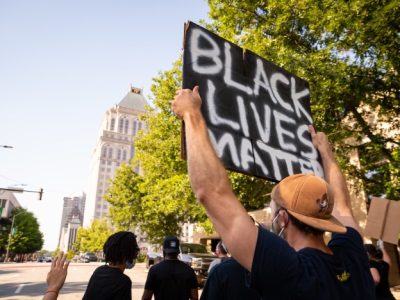 Thanks to a federal court ruling finding that our congressional districts were drawn as an illegal racial gerrymander, North Carolinians will be going back the polls on June 7 to elect candidates in a special primary election.
Thanks to a federal court ruling finding that our congressional districts were drawn as an illegal racial gerrymander, North Carolinians will be going back the polls on June 7 to elect candidates in a special primary election.
It’s tempting to say that another shoe may drop, but as my colleague Brian Clarey has pointed out, the Republican-controlled General Assembly has passed so many laws based on faulty legal analysis and lack of foresight that it seems every day there’s an ongoing stampede of unintended consequences. That said, the heaviest boot ready to land may be a parallel challenge to the redistricting plan for the state General Assembly. It bears noting that the handiwork was completed at the bidding of the same state lawmakers, Sen. Bob Rucho and Rep. David Lewis, in the early summer of 2011. And not least of all, the congressional and state legislative maps were drawn for the same purposes — namely, to pack as many black voters as possible into a handful of districts, and in doing so to pull black voters out of neighboring districts where their support had previously helped elect white Democrats. The name of the Republican game was tipping about four congressional seats into the Republican column and expanding the GOP’s majorities in the two houses of the state legislature.
The ironies of the two sides’ arguments are inescapable. Lawyers for the state defended the maps in federal court in Greensboro last week by arguing that Republican lawmakers wanted to create as many districts with black voting age population above 50 percent as possible out of concern that black voters’ ability to elect candidates of choice was jeopardized by racially polarized voting patterns. This level of concern is strange, to say the least, coming from the party that so clearly would rather isolate black voters than compete for their support, while enacting voter ID and curtailing early voting and other measures that disproportionately burden black voters.
Lawyers from the Southern Coalition for Social Justice, representing the plaintiffs, argued on the other hand that the maps amount to racial segregation because they needlessly pack black voters into a limited number of districts and dilute their ability to influence the outcome of elections in adjacent districts. Their factual argument essentially comes down to the contention that voting in North Carolina is not as racially polarized as the Republicans say it is.
Allison Riggs, a lawyer with the Southern Coalition for Social Justice, attempted to discredit one of the state’s expert witnesses, University of Texas at Dallas political scientist Thomas Brunell, by getting him to repeat a statement he made during depositions.
“I said I wasn’t aware of any opportunity for African Americans to win except in majority black or coalition districts,” Brunell said, later clarifying that by “coalition” he meant other racial minorities such as Latinos, as opposed to a political alliance between blacks and white progressives.
Under cross-examination, Riggs confronted Brunell with the fact that Thomas Wright and Sandra Spaulding Hughes, two black candidates, won election in House District 18, a district straddling New Hanover and Pender counties that was 57.7 percent white. She also cited Ty Harrell, a black candidate who won election to a majority white House district in suburban Wake County, and Larry Shaw, a black Muslim candidate who represented a Senate district in Cumberland County with a population almost evenly split between whites and blacks from 1997 to 2011.
A second expert witness called by the defense, University of Georgia political scientist Trey Hood, indicated he was unimpressed with the plaintiffs’ evidence of black candidates winning elections in districts with percent black voting age populations in the range of 40 to 49 percent.
“The most probative elections are ones with a black candidate and a white candidate,” he remarked drily.
There are few examples of Democratic primaries for state legislative seats with both black and white candidates on the ballot.
The 2010 Senate District 32 primary — with 42.5 percent black voting age population — in Forsyth County stands out as a rare exception. Challenger Ed Hanes, who is black, lost to white incumbent Linda Garrou by a margin of more than 60 percentage points, but Garrou’s influential position as a Democratic budget writer likely enhanced her popularity. When the Republicans took charge, they drew Garrou out of the district, and Earline Parmon, a black candidate, carried it in the next election.
But in neighboring Guilford County, Katie Dorsett, a black candidate, handily won Senate District 28, with 47.2 percent black voting age population, year after year with no difficulty. When Gladys Robinson, a black Democrat ran to replace Dorsett in 2010, she easily prevailed over a white Republican, Trudy Wade, even with another black Democrat, Bruce Davis, siphoning off votes after he got on the ballot as an independent.
It goes to show that there are facts to support virtually any argument.
Join the First Amendment Society, a membership that goes directly to funding TCB‘s newsroom.
We believe that reporting can save the world.
The TCB First Amendment Society recognizes the vital role of a free, unfettered press with a bundling of local experiences designed to build community, and unique engagements with our newsroom that will help you understand, and shape, local journalism’s critical role in uplifting the people in our cities.
All revenue goes directly into the newsroom as reporters’ salaries and freelance commissions.





Leave a Reply